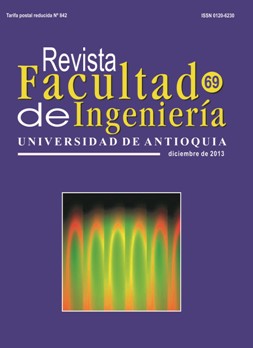Simulation of the soil mechanical behavior in the soil tillage tool interface
DOI:
https://doi.org/10.17533/udea.redin.18133Keywords:
soil, implements, tillage, mechanical soil properties, simulationAbstract
Starting from the development that has reached the computational means in the last decades, the application of the numeric methods in the simulation of the interaction soil tillage-tool, has won in acceptance. As previous step, to the simulation of this phenomenon becomes necessary the definition of the models that predict with more accuracy the soil mechanical behavior. Taking into account these aspects the objective of present work is, to simulate the soil mechanical behavior in the soil-tillage tool interface by means of the finite element method. Starting from the employment of a model that is based on frictional approaches, with the inclusion of the adherence and the establishment of a tension of slip limit, as penalty to restrict the relative displacement between both surfaces. The models were implemented in the computational tool ABAQUS 6.4, starting from that which the soil-metal relative displacement was simulated. The results evidenced the validity of the model implemented to simulate the soil mechanical response in the soil-tool interface. The errors in the prediction of the soil stress oscillated from 1,45 to 5,45%, for the case of the soil vertical deformations it varied among 2,22 to 3,57%.
Downloads
References
R.Young, A. Hanna.”Finite element analysis of plane soil cutting”. J. Terramech. Vol. 14. 1977. pp. 103-125. DOI: https://doi.org/10.1016/0022-4898(77)90010-6
L. Chi, R. Kushawaha. “Finite element analysis of forces on a plane soil blade”. Canadian Agric. Eng. Vol. 31. 1989. pp. 135-140.
L. Chi, R. Kushawaha. “Three dimensional finite element interactions between soil and a simple tillage tool”. Transactions of the ASAE. Vol. 34. 1991. pp. 3623-3626. DOI: https://doi.org/10.13031/2013.31669
R. Kushawaha, J. Shen. “Finite element analysis of the dynamic interaction between soil and tillage tool”. Transactions of the ASAE. Vol. 37. 1995. pp. 1315-1319. DOI: https://doi.org/10.13031/2013.27953
A. Mouazen, M. Nemenyi. A finite element model of soil loosening by a subsoiler with respect to soil conservation. Memorias del 9th Conference of the International Soil Conservation Organisation. Aug 1996. Bonn, Germany. pp. 549-556.
J. Shen, R. Kushwaha. Soil-machine interactions: A finite element perspective. 1a ed. Ed. Marcel Dekker Inc. New York, USA.1998. pp. 325.
U. Rosa, D. Wulfsoh. “Constitutive model for high speed tillage using narrow tools”. Journal of Terramechanics. Vol. 36. 1999. pp. 221-234. DOI: https://doi.org/10.1016/S0022-4898(99)00006-3
M. Abo, R. Hamilton, J. Boyle. “3D dynamic analysis of soil-tool interaction using the finite element method”. Journal of Terramechanics. Vol. 40. 2003. pp. 51-62. DOI: https://doi.org/10.1016/j.jterra.2003.09.002
N. Abu, R. Reeder. “A non linear 3d finite element analysis of the soil forces acting on a disk plow”. Soil Till. Res. Vol. 74. 2003. pp. 115-124. DOI: https://doi.org/10.1016/S0167-1987(03)00152-1
M. Abo, R. Hamilton, J. Boyle. “Simulation of soilblade interaction for sandy soil using advanced 3d finite element analysis”. Soil & Tillage Research. Vol. 75. 2004. pp. 61-73. DOI: https://doi.org/10.1016/S0167-1987(03)00156-9
J. Milton. “Finite element modeling of the interaction of the cutting edge of tillage implements whit soil”. J. Agric. Eng. Res. Vol. 74. 1999. pp. 91-101. DOI: https://doi.org/10.1006/jaer.1999.0440
M. Beeker. Introduction to terrain-vehicle systems. 1a ed. Ed. University of Michigan Press. Ann Arbor, Michigan, US. 1960. pp. 120
G. Clough, J. Duncan. “Finite element analysis of retaining wall behavior”. Journal of the Soil Mechanics and Foundations Division. Vol. 97. 1971. pp. 1657- 1673. DOI: https://doi.org/10.1061/JSFEAQ.0001713
C. Desai, H. Siriwardarne. Constitutive laws for engineering materials, with emphasis on geologic materials. 1a ed. Ed. Prentice Hall, Inc., Englewood Cliffs. New Jersey, USA. 1984. pp. 468.
Q. Zhang, V. Puri, H. Manbeck. “Determination of elastoplastic constitutive parameters for wear en masse”. Transactions of the ASAE. Vol. 29. 1986. pp. 1739-1746. DOI: https://doi.org/10.13031/2013.30382
A. Mouazen, M. Nemenyi. “Tillage tool design by finite element method: Part 1. Finite element modeling of soil plastic behavior”. J. Agric. Eng. Res. Vol. 72. 1999. pp. 37-51. DOI: https://doi.org/10.1006/jaer.1998.0343
S. Karlsson. “Soil triaxial compression”. Abaqus benchmark manual. 6.4. ed. Ed. Pawtucket. Providence, USA. 2004. pp. 35.
S. Karlsson. Abaqus theory manual. 6.4. ed. Ed. Pawtucket. Providence, USA. 2004. pp. 76.
M. Herrera, C. Iglesias, O. Gonzalez, E. López, A. Sánchez. “Propiedades mecánicas de un rhodic ferralsol requeridas para la simulación de la interacción suelo implemento de labranza mediante el método de elementos finitos: Parte I”. Revista Ciencias Técnicas Agropecuarias. Vol. 17. 2008. pp. 31-37.
M. Herrera, C. Iglesias, O. Gonzalez, E. López, A. Sánchez. “Propiedades mecánicas de un rhodic ferralsol requeridas para la simulación de la interacción suelo implemento de labranza mediante el método de elementos finitos:Parte II. Interfase suelo-herramienta”. Revista Ciencias Técnicas Agropecuarias. Vol. 17. 2008. pp. 50-54.
V. Berberena, D. Izada. Estadística. 1a ed. Ed. CIMNE. Barcelona, España. 2006. pp. 350.
Downloads
Published
How to Cite
Issue
Section
License
Copyright (c) 2018 Revista Facultad de Ingeniería

This work is licensed under a Creative Commons Attribution-NonCommercial-ShareAlike 4.0 International License.
Revista Facultad de Ingeniería, Universidad de Antioquia is licensed under the Creative Commons Attribution BY-NC-SA 4.0 license. https://creativecommons.org/licenses/by-nc-sa/4.0/deed.en
You are free to:
Share — copy and redistribute the material in any medium or format
Adapt — remix, transform, and build upon the material
Under the following terms:
Attribution — You must give appropriate credit, provide a link to the license, and indicate if changes were made. You may do so in any reasonable manner, but not in any way that suggests the licensor endorses you or your use.
NonCommercial — You may not use the material for commercial purposes.
ShareAlike — If you remix, transform, or build upon the material, you must distribute your contributions under the same license as the original.
The material published in the journal can be distributed, copied and exhibited by third parties if the respective credits are given to the journal. No commercial benefit can be obtained and derivative works must be under the same license terms as the original work.










 Twitter
Twitter